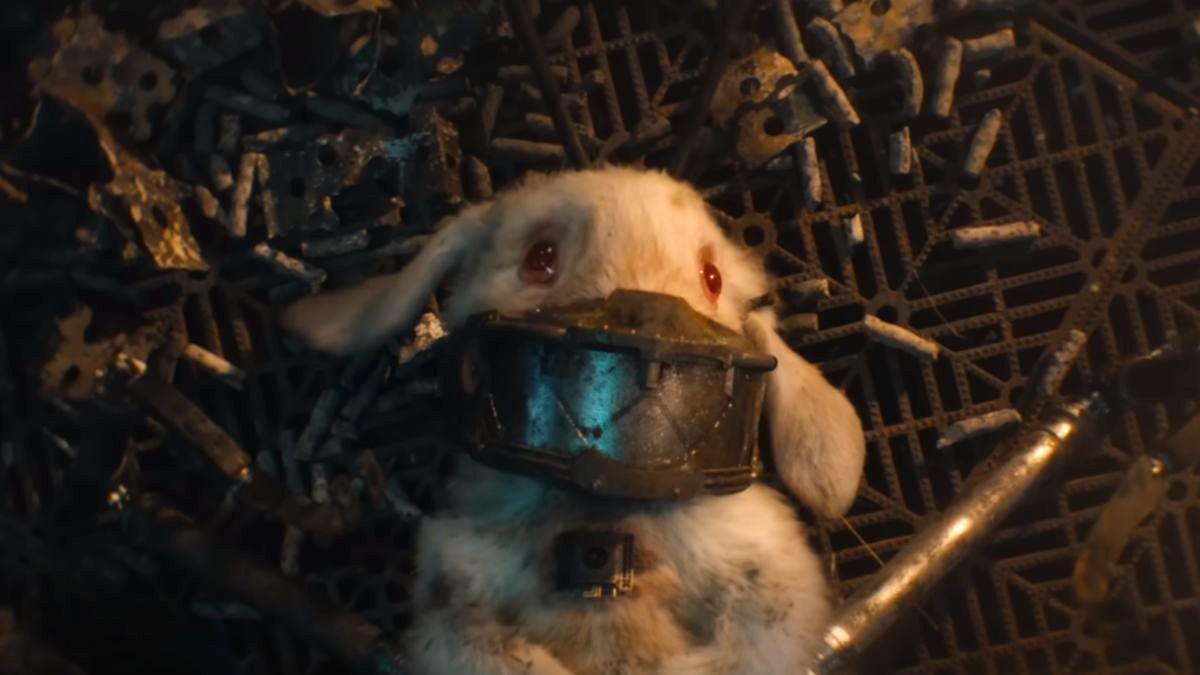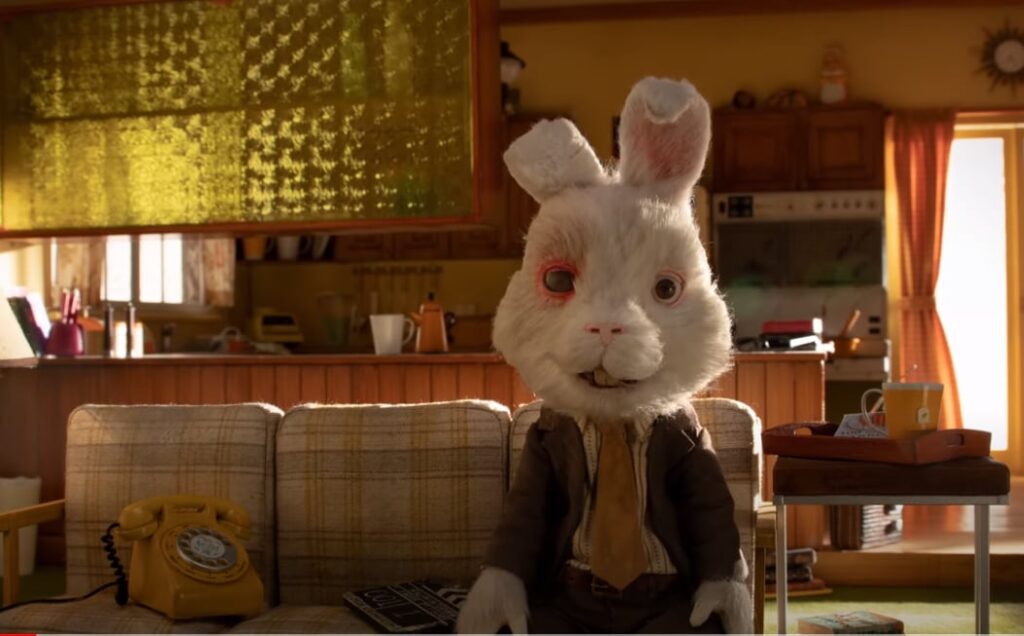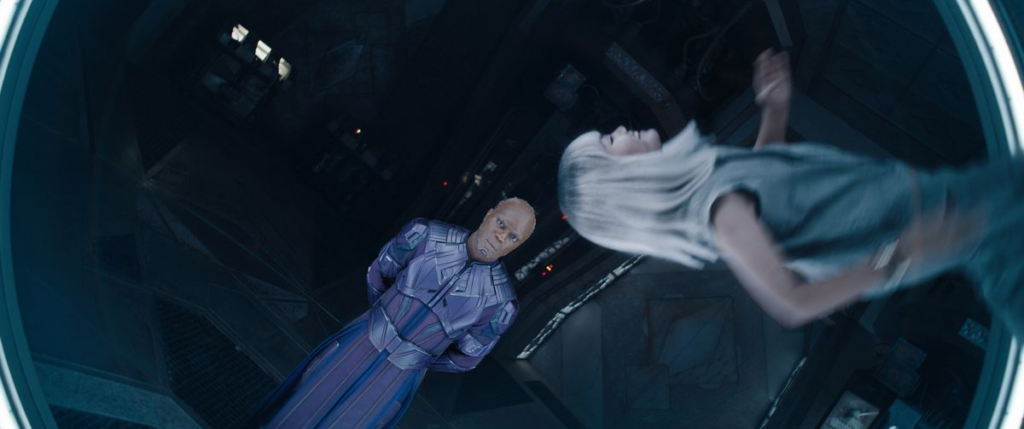The relationship between humans and animals has evolved throughout history. There are countless cases of humans exhibiting a persistent desire to influence the course of evolution in the animal kingdom. This desire to revolutionize animals is often driven by a complex interplay of scientific curiosity, environmental concerns, and the pursuit of benefits for human society. However, juxtaposed against the innate urge to establish superiority above all living beings, this scene of the film demonstrates the contrasting dynamics of the human desire to revolutionize animals and the simultaneous pursuit of dominance and power.

The Guardians of the Galaxy Vol. 3, dir. James Gunn (Marvel Studios, 2023).
“Guardians of the Galaxy Vol. 3,” the beloved misfit heroes, led by Star-Lord, embark on a cosmic quest to thwart a looming celestial menace. A unique twist unfolds as the Guardians discover an ancient prophecy tied to a cosmic phenomenon, the emergence of the Cosmic Menagerie. This mystical force connects with a whimsical assortment of alien animals scattered across the galaxy, each possessing extraordinary abilities. Rocket, the clever raccoon, takes charge as the team endeavors to unite these quirky creatures, fostering unexpected friendships and revealing the untapped potential within each. As the Guardians confront personal challenges and cosmic threats, the narrative weaves humor, heart, and spectacle. The journey unfolds into a heartening exploration of the bonds formed between our misfit heroes and their newfound animal allies. “Guardians of the Galaxy Vol. 3” promises a visually stunning, emotionally resonant journey, where the power of camaraderie and the extraordinary synergy between humans and cosmic critters unfolds against the backdrop of the infinite universe.
“Guardians of the Galaxy Vol. 3” boldly navigates the cosmic adventure genre, seamlessly weaving together elements of science fiction, comedy, and heartfelt drama. This installment continues the franchise’s tradition of delivering a distinctive cinematic experience through its visually striking landscapes, diverse characters, and a soundtrack that enhances the storytelling. Within this cosmic tapestry, the film’s unique style unfolds, harmonizing spectacular visuals with emotionally resonant narratives. The genre’s hallmark, a perfect blend of humor and profound character development, immerses audiences in a rollercoaster of emotions.
An intriguing facet of this cinematic journey is the representation of animals, introducing cosmic creatures that transcend the ordinary. These whimsical beings not only contribute to the visual spectacle but also play a pivotal role in shaping the narrative. Through the lens of cosmic adventure, “Guardians of the Galaxy Vol. 3” explores the extraordinary synergy between the Guardians and their alien animal allies, infusing the film with enchantment and wonder. The result is a promise of a visually stunning, emotionally engaging, and delightfully unconventional cinematic escapade.
The Guardians of the Galaxy Vol. 3, dir. James Gunn (Marvel Studios, 2023).
Throughout the film, the language and behaviours of human-animal relationships are indistinct. Rocket is named P13, without a proper name but a numeric code easy to identify as mere beings made in the process of reaching a higher goal, yet still called “him” instead of “it”. Furthermore, Rocket seems to be caressed on the High Evolutionary’s lap while he calculates a mathematical equation. However, this warming touch quickly transitions to The High Evolutionary grabbing Rocket by the face and almost choking him while using an anthropocentric tone to almost threaten him. Uncovering his belief to fulfil a duty to take an “imperfect clump of biological matter” and transform it into his understanding of a perfect being. The camera angles in this scene demonstrate the power dynamic of humans and animals whereby the angle is zoomed into the High Evolutionary’s face at a high-angle asserting dominance to the blurred effect of Rocket who is positioned at a lower angle. When the camera zooms in and focuses on Rocket the High Evolutionary is still luring over showing the hierarchy of humans and animals.
The scene continues this human-animal relationship of evolution and dominance, referring to Rocket as P13 and openly telling him that he is from Batch 89. This moment shows that animals who are only used as testers, such as Rocket who has irremovable scars from animal testing, are treated as emotionless creatures only intended to be sacrificed for the bigger goal. The constant animal testing is justified with the aim of creating the “perfect species”. Not only was Rocket, the raccoon, tested and torchered for the excuse of the perfect species, but alongside him Floor the rabbit, Teefs the walrus and Lylla the otter impacted the narrative of animal cruelty and animal testing in the film.
Another short film about animal testing is “Save Ralph”, written and directed by Spencer Susser. This stop-motion animated short addresses the issue of animal testing and cruelty. Released in 2021, “Save Ralph” features Ralph, a lab rabbit, and provides a poignant perspective on the impact of cosmetic testing on animals. The film was produced by the Humane Society International.
While the characters Floor from “Guardians of the Galaxy 3” and Ralph from “Save Ralph” belong to different cinematic universes and genres, there are striking similarities in the challenges they face, highlighting poignant themes of mistreatment and the quest for freedom. Floor and Ralph are both white rabbits that undoes animal cruelty and animal testing for better, whether it be to make a superior species or for the safety of human cosmetics, both animals are abused due to the greed of humans.

Floor from Guardians of the galaxy 3


Ralph from Save Ralph
Floor, akin to Ralph, undergoes a journey marked by adversity. In “Guardians of the Galaxy 3,” Floor exemplifies the struggle of beings subjected to dehumanizing treatment. The character serves as a narrative vehicle to explore themes of animal cruelty, portraying the impact of scientific experimentation and the blurred lines in human-animal relationships. Floor’s quest for autonomy mirrors Ralph’s plight in “Save Ralph,” where the latter, an animated rabbit, represents the countless animals subjected to cosmetic testing. Both characters embody the harsh reality of beings exploited for human objectives, shedding light on the ethical dilemmas surrounding such practices.
Additionally, Floor and Ralph share a symbolic role in challenging human perspectives. Their intelligence and resilience challenge the assumed superiority of humans, creating a clash between the pursuit of power and the intrinsic right of every being to live free from exploitation. Whether in a sci-fi adventure or an animated short film, these characters serve as poignant reminders of the ethical responsibilities tied to scientific advancements and human interactions with the animal kingdom. In exploring these parallels, it becomes evident that Floor and Ralph contribute to a broader narrative that encourages reflection on the treatment of sentient beings, underscoring the need for empathy and ethical considerations in both fictional and real-world contexts.
The unending desire to create and evolve is shown not only within humans but also the technological development. Using a machine, the turtle is transformed within seconds into a two-legged human-like turtle. The turtle which at first was unharmful, shows pain as his body changes in a rapid time. However, due to an over-producing of chemicals in the machine, the turtle turns violent and so the High Evolutionary just kills him heartlessly.
The High Evolutionary comments on this saying that the species of Utopia cannot be killing one another. This raises an irony as humans are categorized as “animals” and humans too kill animals for our purpose. The High Evolutionary tortures animals for his desire to create a perfect species yet he too is imperfect if his definition of the perfect species is unharmful.
The question then is how the imperfect ruler is destined to rule his perfect species without perfection himself. When Rocket, an imperfect being labeled by the High Evolutionary, solves the problem of the machine and outsmarts humans, the urge to evolutionize animals with contrasts with the pursuit of superiority clashes.


Counter-Earth in Guardians of the Galaxy Vol 3 (Marvel Studios, 2023).
The representation of animals and human-animal relations in the film, particularly in the Counter-Earth scene, serves as a nuanced exploration of the complex interplay between humans and animals. James Gunn’s meticulous direction and storytelling offer a critical lens through which the audience can examine the contrasting dynamics of human desires to revolutionize animals while simultaneously pursuing dominance and power.
Counter-Earth, with its inhabitants referred to as “humanimals,” presents a compelling vision of a world where the boundaries between human and animal are blurred. The suburban setting, complete with a warthog pushing a stroller and a panda tending to the lawn, challenges conventional notions of humanity. The Guardians’ arrival disrupts this peaceful scene, revealing both the curiosity and potential for chaos inherent in human-animal interactions.
The introduction of the bat-woman adds layers to the narrative. Her resilience in the face of chaos and her willingness to welcome extraterrestrial visitors into her home become symbolic of bridging the gap between species. Gunn’s portrayal of the bat-woman’s domestic life, from caring for her children to her husband bringing refreshments, humanizes her in a way that transcends traditional distinctions between humans and animals.
The symbolism extends to the Guardians’ interactions with the humanimals. Peter’s compassionate response to the bat-woman’s injury and the Guardians’ expressions of gratitude highlight the potential for understanding and cooperation between species. The act of surrendering the family car, despite initial hesitation, signifies a shared sense of goodwill and unity. Gunn skillfully navigates these moments, portraying the humanimals as Good Samaritans, challenging the preconceived notions of human superiority.
Nebula’s rare burst of joy over a fizzy blue beverage becomes a poignant instance. Her reaction underscores the universal nature of joy and pleasure, transcending species boundaries. The deliberate pause to showcase the family’s generosity emphasizes the common threads that bind diverse species, emphasizing kindness as a unifying force.
Gunn’s attention to detail is evident in the ordinary aspects of the bat-woman’s life, from family photos to the dining room tableau. These elements serve to humanize the humanimals, fostering empathy and connection with the audience. The director deliberately contrasts the chaos initiated by Drax’s accidental action with the subsequent warmth and understanding extended by the bat-woman, creating a narrative tension that underscores the film’s exploration of human-animal relations.
In essence, this scene becomes a microcosm of the broader theme running through the film—the desire to revolutionize animals and the pursuit of dominance versus the potential for understanding, unity, and shared kindness. Gunn’s storytelling transcends the superficial, inviting the audience to question established norms and consider the possibilities of a more harmonious coexistence between humans and animals. The meticulous blend of humor, heart, and narrative subtleties in this Counter-Earth scene elevates it into a heartwarming exploration of unexpected connections and the potential for unity in a diverse cosmic tapestry.
Gunn’s vision of the perfect world created by humanimals excluding any anthropocentric visions ironically clashes with the creator or the perfect world desgined by the High Evolutionary. The perfectly kind and gentle beings were programmed with the sacrifice of other animals who were tested for the perfect DNA. The anthropocentric world and ideology of the High Evolutionary designing animals to work as machines playing the antagonist of the film. However he also created the perfect world which he invisions to be anti-anthropocentric and peaceful, which in it, he wishes to play the role of god.

High Evolutionary designing his perfect species (Marvel Studios, 2023).
The film “Guardians of the Galaxy Vol. 3” intricately explores the evolving dynamics between humans and animals in the context of a cosmic adventure. The juxtaposition of the Guardians’ cosmic quest and the portrayal of humanimals on Counter-Earth serves as a microcosm of the broader theme, questioning human desires to revolutionize animals and the pursuit of dominance. James Gunn’s attention to detail, humor, and emotional depth in the Counter-Earth scene encapsulates the potential for unity and understanding between species, challenging traditional hierarchies. The film challenges ingrained human superiority through nuanced interactions with humanimals. Despite disruptions, moments of compassion, gratitude, and shared kindness emphasize the potential for understanding and cooperation across species. The contrasting visions of a perfect world—one designed by the High Evolutionary and the other unintentionally created by humanimals—highlight the irony in anthropocentric ideologies. The pursuit of a utopia involves sacrifices and unintended consequences, prompting reflection on the ethical implications of human-animal relationships.
“Guardians of the Galaxy Vol. 3” offers a thought-provoking exploration of the evolving relationship between humans and animals, challenging conventional narratives. Gunn’s narrative intricacies and thematic depth elevate the film beyond its cosmic adventure genre, inviting audiences to reconsider established norms. The film encourages reflection on the ethical responsibilities tied to scientific advancements, the impact of hierarchical power dynamics, and the potential for unity in diverse cosmic tapestries.
Citation:
Guardians of the galaxy vol. 3 (2023) IMDb. Available at: https://www.imdb.com/title/tt6791350/ (Accessed: 30 December 2023).
Puchko, K. (2023) guardians of the galaxy vol. 3, Mashable. Available at: https://mashable.com/article/guardians-of-the-galaxy-3-bat-people (Accessed: 30 December 2023).
Ralph (2023) Humane Society International. Available at: https://www.hsi.org/saveralphmovie/ (Accessed: 30 December 2023).